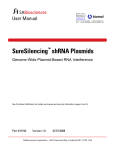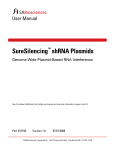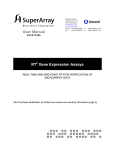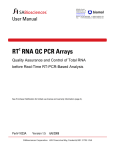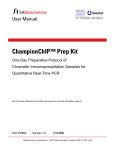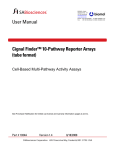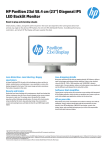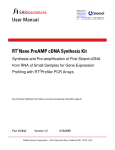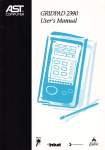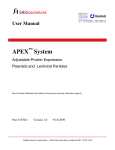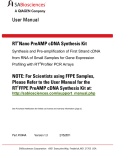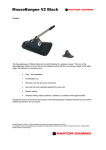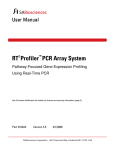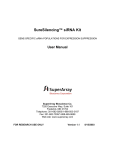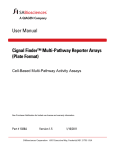Download User Manual - Biomol GmbH
Transcript
BIOMOL GmbH Waidmannstr. 35 22769 Hamburg [email protected] www.biomol.de Phone:+49-40-8532600 or 0800-2466651 (D) Fax: +49-40-85326022 or 0800-2466652 (D) User Manual ™ SureSilencing siRNA Genome-Wide High Purity Synthetic RNA Interference See Purchaser Notification for limited use license and warranty information (pages 2 and 4). Part #1043A Version 1.1 1 03/24/2009 ™ SureSilencing siRNA Genome-Wide High Purity Synthetic RNA Interference User Manual BIOMOL GmbH Waidmannstr. 35 22769 Hamburg [email protected] www.biomol.de Phone:+49-40-8532600 or 0800-2466651 (D) Fax: +49-40-85326022 or 0800-2466652 (D) (For Catalog Numbers SIH######X, SIM######X, SIR######X) Ordering and Technical Service Contact Information: Tel: Fax: On-line Order: E-MAIL: 1-888-503-3187 (US) 301-682-9200 (outside US) 301-682-7300 (outside US) 1-888-465-9859 (US) www.sabiosciences.com [email protected] (to place an order) [email protected] (for technical support) You may place orders by fax, e-mail or from our website. Each order should include the following information: Your contact information (name, phone, email address) Product name, catalog number and quantity Purchase order number or credit card information (Visa or MasterCard) Shipping address Billing address For more information, visit us at www.sabiosciences.com NOTICE TO PURCHASER I This product is made under license from The Carnegie Institution of Washington. However, the purchase of this material by a nonacademic or for-profit organization will require a license to use the material from Carnegie. License queries may be directed to Gloria Brienza or Gary Kowalczyk at The Carnegie Institution of Washington, 1530 P Street NW, Washington, DC 20005. LIMITED PRODUCT WARRANTY This product is intended for research purposes only and is not intended for drug or diagnostic purposes or for human use. This warranty limits our liability to replace this product in the event the product fails to perform due to any manufacturing defect. SABiosciences Corporation makes no other warranties of any kind, expressed or implied, including without limitation, warranties of merchantability or fitness for a particular purpose. SA Bioscience Corporation shall not be liable for any direct, indirect, consequential or incidental damages arising out of the use, the results of use or the inability to use this product. NOTICE TO PURCHASER II The purchase of SureSilencing™ siRNA includes a limited, nonexclusive license to use it for research use only. This license does not grant rights to use it for resale or to use SureSilencing™ siRNA to manufacture commercial products without written approval of SA Bioscience Corporation. No other license, expressed, implied or by estoppels, is granted. U.S. patents may cover certain isolated DNA sequences included in the SureSilencing™ siRNA. Presently, it is not clear under U.S. laws whether commercial users must obtain licenses from the owners of the rights to these U.S. patents before using SureSilencing™ siRNA. CONTENTS I. Background and Introduction 4 II. Kit Contents 6 III. Additional Materials Required 7 IV. Protocol 8 A. Transfection 8 B. Assay Effects of Silencing Gene Expression 10 V. SureSilencing siRNA FAQ 11 VI. Troubleshooting Guide 12 Appendix: Real-time RT-PCR Protocol for Verifying Suppression Technical Support: [email protected] 3 14 www.sabiosciences.com I. Background and Introduction RNA Interference, a now commonplace and popular method for exploring gene function, suppresses the expression of a specific gene of interest in transformed mammalian cell culture or even in animal model. Upon suppression, missing or altered activities in the cell can be attributed to the function of the affected gene. The most commonly used technique, small interfering RNA (siRNA), is useful for many applications and has been proved to work optimally in many cells with high efficacies. SureSilencing siRNA are designed using an experimentally validated algorithm. These synthetic double strands RNA specifically knock down the expression of specific genes by RNA interference. Each synthetic siRNA duplex is HPLC purified to provide the maximum amount of full length strand to target your gene of interest in full power. Our experimentally verified siRNA design algorithm assures gene knockdown specificity and efficacy. An advanced specificity search in addition to BLAST built into the algorithm helps to reduce the potential off-target effects. At least two of the 4 provided SureSilencing siRNAs in each set is guaranteed to knock down the expression of target gene at the mRNA level by at least 70 percent in well transfected cells. ™ Benefits of the SureSilencing synthetic siRNA: High Purity with low price: All of our synthetic siRNA is HPLC purified that provides high quality siRNA to increase knockdown efficacy and lower off-target effects. GUARANTEED!*: Knock down the expression of any targeted human, mouse or rat gene by at least 70 percent with the full set order. Control for non-specific and off-target effects. Convenient with customization opportunity: People can order the full set or individual one for their preference. If customer has their own design in-hand, customized synthesis is also available. * At least two of the four provided pre-designed SureSilencing™ siRNA are guaranteed to knock down the expression of target gene at mRNA level by at least 70 percent, as measured by real-time qRT-PCR in transfected cells as described in this User Manual. SureSilencing siRNA comes with a one-time–only replacement offer. If a set of SureSilencing siRNAs is ordered and less than 2 of the siRNAs result in gene silencing, SABiosciences will provide 4 additional siRNAs free of charge, once only. You will be asked to provide supporting data, demonstrating that the siRNA failed to knock down the target gene by at least 70% at the mRNA level under appropriate transfection conditions. Supporting data should include transfection efficiency data, quantitative silencing data, and data showing ≥ 70% knockdown of a positive control. This offer is valid for up to 6 months after the date of delivery. Technical Support: [email protected] 4 www.sabiosciences.com Mix siRNA with SureFECT transfection reagent Do reverse transfection for your cells Isolate total RNA for checking knock down efficiency, or for your phenotype assay ™ Figure 1: Overview of SureSilencing Synthetic siRNA Procedure. Technical Support: 888.503.3187 (US) 5 301.682.9200 II. Kit Contents and Related Information A. siRNA (Set) Contents: Component siRNA InfoSheet Specification SureSilencing™ siRNA, 12.5nmol in each tube SureSilencing siRNA InfoSheet with siRNA sequences Quantity Four (4) One (1) B. siRNA (individual) Content: Component siRNA InfoSheet Specification SureSilencing™ siRNA, 12.5 nmol in each tube SureSilencing siRNA InfoSheet with siRNA sequences Quantity One (1) One (1) Resuspension Instruction: Resuspend lyophilized siRNA duplex in 625 µl RNase-free ddH2O to get a 20 µM stock solution. Aliquots are recommended when repeated use is needed. Storage Conditions: All components included with this catalog number are shipped in ambient temperature. Store lyophilized siRNA duplex at -20 °C or below. Stable for at least 6 month from the date of shipment. Once resuspended, store at -20 °C or below in non-frost-free freezer, avoid contact with RNases and repeated freeze thaw cycles. Technical Support: [email protected] 6 www.sabiosciences.com III. Additional Materials Required: A. For Transfection: We recommend using SureFECT™ Transfection Reagent (SABiosciences Cat. No. SA-01). B. For Support Reagents siRNA Transfection Reagent: SureFECT™ Transfection Reagent SA-01 Negative Control siRNA: SIH165860A SIM166769A SIR766773A RT-PCR Gene Specific Primer: Please check our website at: http://www.sabiosciences.com/RT2PCR.php RT-PCR House Keeping Gene Primer: Please check our website at: http://www.sabiosciences.com/QRTsearch.php?target=housekeeping B. For Real-Time RT-PCR Verification of Gene Suppression: 1. RT² First Strand Kit Catalog Number C-03 2. SABiosciences RT2 Real-Time™ SYBR Green PCR Master Mix Be sure to pick the correct one for the instrumentation in your laboratory. RT2 Real-Time™ SYBR Green / ROX: Specifically designed for: All ABI and Stratagene Instrumentation Eppendorf Mastercycler® ep realplex Instruments with ROX filter set Catalog Number Size PA-012 For 2 RT2Profiler™ PCR Arrays PA-012-12 For 12 RT2Profiler™ PCR Arrays PA-012-24 For 24 RT2Profiler™ PCR Arrays RT2 Real-Time™ SYBR Green / Fluorescein: Specifically designed for BioRad iCylcer®, MyiQ®, and iQ5 Instrumentation Catalog Number Size PA-011 For 2 RT2Profiler™ PCR Arrays PA-011-12 For 12 RT2Profiler™ PCR Arrays PA-011-24 For 24 RT2Profiler™ PCR Arrays 2 RT Real-Time™ SYBR Green: Specifically designed for instrumentation that does not require a reference dye: BioRad (MJ Research) Opticon, Opticon 2, and Chromo 4 Roche LightCycler® 480 System Eppendorf Mastercycler® ep realplex Instruments without ROX filter set Catalog Number Size PA-010 For 2 RT2Profiler™ PCR Arrays PA-010-12 For 12 RT2Profiler™ PCR Arrays PA-010-24 For 24 RT2Profiler™ PCR Arrays Technical Support: 888.503.3187 (US) 7 301.682.9200 3. RT2 PCR Primer Assay targeting the suppressed target gene of interest and a housekeeping gene, such as ACTB of GAPD, to normalize the real-time PCR results. Find the primer at: http://www.sabiosciences.com/RT2PCR.php PPH00073E-200: PPH00150E-200: PPM02945A-200: PPM02946E-200: PPR06570B-200: PPR06557A-200: RT² PCR Primer Set for Human ACTB RT² PCR Primer Set for Human GAPDH RT² PCR Primer Set for Mouse Actb RT² qPCR Primer Set for Mouse Gapdh RT² PCR Primer Set for Rat Actb RT² qPCR Primer Set for Rat Gapdh 4. RT² qPCR-Grade™ RNA Isolation Kit (SABiosciences Cat. No PA-001) Technical Support: [email protected] 8 www.sabiosciences.com IV. Protocol: A. Transfection: We recommend the use of SureFECT transfection reagent (SABiosciences Cat. No. SA01). For virtually all cell lines tested, SureFECT is an exceptional transfection reagent, providing maximal transfection efficiency and minimal toxicity. If you have already optimized a transfection reagent and protocol for your cell line of interest, you may use that protocol to transfect the SureSilencing siRNA into the same cell line. Just be sure that the original protocol optimization used siRNA and assayed percentage of mRNA or protein knockdown or functional inhibition. We recommend using reverse transfection protocols with the SureFECT transfection reagent. This is due to the time savings and improved reproducibility of using this method, compared to traditional forward transfection methods. SureFECT will also work well as a reagent for traditional forward transfection methods. The following protocols are written on a per well basis, and are designed for the transfection of an adherent cell line, Hela (ATCC), with the SureFECT transfection reagent, using a 96-well cell culture plate. We recommend that you set up three (3) replicate transfections for each of the four gene-specific siRNAs and the negative control SureSilencing siRNA using an optimized transfection protocol. Reverse Transfection Protocol This is just a general guideline for 96 well transfection; the optimal conditions or amounts should be determined for each new cell line/cell type being transfected. a. On the day of transfection, dilute 0.3 l SureFECT with 37.7 l Opti-MEM I medium for each well (the optimized condition for different cell line should be evaluated by customer). b. Mix 2 pmol (2 l) of each gene-specific siRNA and the negative control siRNA into 38 l of the above Opti-MEM™ I diluted SureFECT (total volume = 40 l). Mix gently. Prepare separate mixtures for each replicate. c. Incubate 40 l of the siRNA-SureFECT™ mixture in each well for 20 min at room temperature. d. Add 160 l cell suspension (prepared during the incubation step) at 8000~12000 cells/160 l in regular culture media to each well of 96-well plate. Mix gently. e. Incubate the cells at 37 °C in a CO2 incubator for 24 to 72 hours. f. Determine the target gene knock down at 48 hours (recommended) after transfection with real-time PCR. g. Determine the phenotype change at the time point you optimized for your experiments. Technical Support: 888.503.3187 (US) 9 301.682.9200 Plating Format Surface Area 2 μM siRNA SureFECT (wells/plate) (cm2/well) (l) (l) 96 24 12 6 0.3 2 4 10 3 9 18 36 0.3 1.5 3 6 Serumfree Medium (l) 40 100 150 200 Total Plating volume cell number (l) per well 200 600 1200 2400 10000 50000 1000000 200000 Table 1. Recommended volumes for transfecting 30 nM* siRNA in various plating formats. SureFECT volumes and other conditions per well represent guidelines and may need to be optimized. *Note: 30 nM = 30 nmol/L = 30 pmol/mL = 30 fmol/μL Traditional Forward Transfection Protocol This is just a general guideline for 96 well transfection; the optimal conditions/amounts should be determined for each new cell line/cell type being transfected. a. One day before transfection, seed 6000 cells in each well of 96-well plate with 200 l of growth medium. b. On the day of transfection, mix 2 pmol (2 l) of each gene-specific siRNA or the negative control siRNA into 38 l of the above Opti-MEM™ I Medium diluted SureFECT (total volume = 40 l). Mix gently. Prepare separate mixtures for each replicate. c. Incubate for 20 min at room temperature and add 40 l of the siRNASureFECT™ mix to each well. d. Add 160 l of regular fresh media to each well. Mix gently. e. Incubate the cells at 37 °C in a CO2 incubator for 24 to 72 hours. f. Determine the target gene knock down at 48 hours (recommended) after transfection with real-time PCR. g. Determine the phenotype change at the time point you optimized for your experiments. Our rigorous real-time RT-PCR protocol for verifying suppression by RNA interference relies on triplicate transfections for each gene-specific siRNA design and the negative control siRNA for statistically significant results. See the Appendix of the User Manual for more details. Other siRNA delivery method protocols For using other siRNA delivery methods such as electroporation, please refer the manufacturer’s protocol for your cell line. Technical Support: [email protected] 10 www.sabiosciences.com C. Assay Effects of Silencing Gene Expression There are many ways to characterize the cellular effects caused by a decrease in the expression of a specific gene meditated by RNA Interference. The following is a brief list of possible ways. However, your experiments do not need to be limited by these suggestions. Cells may be harvested, and RNA isolated for gene expression analysis using: SABiosciences’ RT2Profiler™ PCR Arrays SABiosciences’ RT2 Real-Time™ PCR Primer Sets and SYBR Green Master Mixes SABiosciences’ GEArray® Focused DNA Microarrays Cells may be harvested, and protein isolated for: SDS-PAGE and Western Verification SABiosciences’ Multi-Analyte Profiler ELISArray™ Kits SABiosciences’ Single Analyte ELISA Kits Biochemical Assays Cells may be left in wells or plates for: SABiosciences’ Cellular Activation Signaling ELISA (CASE™) Kits Cell biological assays such as morphology and immunofluorescence staining Technical Support: 888.503.3187 (US) 11 301.682.9200 V. SureSilencing siRNA FAQs What is the SureSilencing siRNA guarantee? We guarantee that at least two of the set of four SureSilencing siRNA will knock down the expression of target gene by at least 70 percent in transfected cells as measured by realtime qRT-PCR relative to negative control siRNA-transfected cells using an optimized siRNA delivery condition. Please follow the recommendations in this User Manual to ensure the optimal level of knockdown. If more than two of the siRNAs in one set fail to knock down target gene expression, please contact our Technical Support to discuss your results and be prepared to provide your results in an Excel file as an email attachment. If a product failure is verified, we will send you another set of four pre-designed siRNAs for free. What transfection method should I use with the SureSilencing siRNA? We recommend using the SureFECT transfection reagent (SABiosciences Cat. No. SA01). For the majority of cell lines tested, it is an exceptional reagent, providing superior combination of maximal transfection efficiency and minimal cytotoxicity. If you have a previously optimized siRNA transfection method for your cell line, you may use that method to transfect the SureSilencing siRNA. To quickly optimize transfection conditions, use a system that encodes an easily screening marker, such as GAPDH based enzyme activity assay. If your cells do not transfect well with lipid-based or chemical-based methods, electroporation method such as those provided by Lonza/Amaxa may be a useful alternative. Can I use the SureSilencing siRNA with primary cells or macrophages or for injection into live animals? Yes, there are many publications that have shown the efficient delivery of siRNA into primary cells, macrophages or other cell lines, and even animals with different methods. For these applications, we recommend finding relevant references describing proven methods before beginning your experiments. Technical Support: [email protected] 12 www.sabiosciences.com VI. Troubleshooting Guide A. Low transfection efficiency 1. Transfection efficiency primarily depends on the cell line used. Therefore, it is very important to optimize the transfection conditions for each cell type under study. Variable details to consider when optimizing the transfection conditions include cell density, cell viability, amount of siRNA, ratio of siRNA to transfection reagent, transfection complex formation time, and transfection incubation time (see the detailed protocols for our recommendations). 2. Use our positive control siRNA to optimize transfection efficiency. 3. If using the FAM labeled SureSilencing siRNA: Observe the cells carefully with fluorescence microscope under high power field. Check the transfected (FAM-positive) cells and the total number of cells (nuclear DNA stain) in the same fluorescent view of the same microscope field. Be sure to obtain numbers from several different randomly-chosen microscope fields in the interior (not toward the edges) of the cell culture well. The labeled siRNA signal is not as strong as EGFP signal you may ever see. The wash is necessary before observation in order to lower the background. Observations for long time may bleach the FAM signal. NOTE: DO NOT try to use the phase (cell) and fluorescence (GFP) views separately to estimate or count the total number of cells and the number of transfected cells, respectively. B. Knockdown not distinguishable by real-time PCR 1. Poor transfection efficiency: Make sure that your transfection efficiency is optimized. You must be looking at a population of cells that is nearly 100 percent transfected for an accurate determination of knockdown. 2. Poor real-time PCR reproducibility: Make sure that your triplicate real-time PCR threshold cycle values demonstrate a high degree of reproducibility with a standard deviation of roughly 0.25 to 0.33 cycles. A seventy (70) percent knockdown of expression will be observed as only a 1.74 difference in normalized Ct values for negative control vs. gene-specific siRNA transfected cells. This specific level of reproducibility is required to reliably detect such a difference. 3. Low level of expression of gene of interest: To accurately determine knockdown by real-time PCR, the level of expression of the gene of interest in control or un-transfected cells should be at least reasonably well expressed with a Ct value less than 30. Real-time PCR cannot determine the relative expression of genes expressed at a lower level (Ct > 30) with enough reproducibility to detect a seventy (70) percent knockdown of expression. Try using more input RNA (up to 5 g) in the reverse transcription reaction and only dilute the Technical Support: 888.503.3187 (US) 13 301.682.9200 completed reaction by four-fold, adding 60 instead of 100 l of ddH2O, but still use 10 l of the dilution to setup the PCR. 4. Real-time PCR analysis not performed properly: Make sure that real-time PCR analysis was set up and performed properly. Consult the Troubleshooting Guide of the RT2 Gene Expression Assay User Manual if using the RT2 PCR Primer Sets and RT2 Real-Time™ SYBR Green PCR Master Mixes from SABiosciences. If using other reagents for real-time PCR, consult the original manufacturers’ recommendations and suggestions. Note: Only use real-time PCR to determine the level of knock-down. No other RNA detection method (e.g. Northern Blot or conventional PCR) will be quantitative enough to observe a 70 percent knockdown. Western Blot is also unreliable because the success of knockdown at the protein level also depends on the quality of the antibody and the biological half-life of the protein, whereas RNA interference specifically acts at the RNA level. (See below.) C. The expression at RNA level is decreased but no decrease is observed at the level of protein or biochemical assay The RT-PCR verification will confirm that expression has been decreased at the level of messenger RNA and that the SureSilencing siRNA functioned correctly. A change in the RNA level for a particular gene does not necessarily immediately correlate with a change in the amount of protein in the cell. If the protein has a long half-life, protein level change will take much longer to occur than RNA level change. Technical Support: [email protected] 14 www.sabiosciences.com Appendix. Real-time RT-PCR Protocol for Verifying Suppression A detailed description of the theory behind RNA interference validation using real-time PCR may be found in our white paper entitled: “Did Your RNAi Experiment Work?! Reliably Validating RNA Interference with Real-Time PCR” For statistically significant results, the method relies on triplicate transfections for each gene-specific siRNA design and the negative control siRNA. It also requires triplicate realtime PCR reactions to characterize the targeted gene of interest (GOI) and a housekeeping gene (HKG) to normalize the results using the total RNA sample from each transfection. (Typical housekeeping genes include β-actin and GAPDH.) Table 1: Setting up real-time PCR validation of suppression The triplicate reactions for each gene in all five triplicate transfections may be conveniently setup in a 96-well PCR plate as depicted in this table. The table represents a 96-well plate. The reactions in the first set of six numbered columns will characterize expression of the GOI in the indicated RNA samples, while the second set of six numbered columns will characterize expression of the HKG in the corresponding RNA samples. 1 A B C D E F G H 2 3 4 5 6 Design1 Txn1 NC Design Txn3 P1 P2 P3 P1 P2 P3 Design1 Txn2 Design3 Txn1 P1 P2 P3 P1 P2 P3 Design1 Txn3 Design3 Txn2 P1 P2 P3 P1 P2 P3 Design2 Txn1 Design3 Txn3 P1 P2 P3 P1 P2 P3 Design2 Txn2 Design4 Txn1 P1 P2 P3 P1 P2 P3 Design2 Txn3 Design4 Txn2 P1 P2 P3 P1 P2 P3 NC Design Txn1 Design4 Txn3 P1 P2 P3 P1 P2 P3 NC Design Txn2 BLANK P1 P2 P3 Samples in column 1 to 6 are amplified using PCR primers specific for the GOI. Technical Support: 7 888.503.3187 (US) 15 8 9 10 11 12 Design1 Txn1 NC Design Txn3 P1 P2 P3 P1 P2 P3 Design1 Txn2 Design3 Txn1 P1 P2 P3 P1 P2 P3 Design1 Txn3 Design3 Txn2 P1 P2 P3 P1 P2 P3 Design2 Txn1 Design3 Txn3 P1 P2 P3 P1 P2 P3 Design2 Txn2 Design4 Txn1 P1 P2 P3 P1 P2 P3 Design2 Txn3 Design4 Txn2 P1 P2 P3 P1 P2 P3 NC Design Txn1 Design4 Txn3 P1 P2 P3 P1 P2 P3 NC Design Txn2 BLANK P1 P2 P3 Samples in column 7 to 12 are amplified using PCR primers specific for the HKG. 301.682.9200 Unless otherwise indicated, follow the protocols described in the RT2 Gene Expression Assays User Manual included with the SABiosciences RT2 PCR Primer Sets 1. RNA Isolation a. Isolate total RNA from each of the 15 transfections. b. For cultured cells, use the RT² qPCR-Grade™ RNA Isolation Kit (PA-001). Be sure to include the recommended DNase treatment step. c. Also, make sure to perform the RNA quality control described in the RT2 Gene Expression Assays User Manual. 2. Reverse Transcription (First Strand cDNA Template Synthesis) a. Perform one reverse transfection for each of the 15 total RNA samples (one per transfection). a. Follow the instructions in the RT2 Gene Expression Assays User Manual included with the RT2 PCR Primer Sets. b. For convenient pipetting below, dilute each completed 20-l RT reaction 50-fold by adding 980 l of ddH2O. 3. Primer Set and Master Mix Cocktail For real-time PCR, prepare two separate cocktails, one for the GOI and one for the HKG, using the following recipe: Component 2X SABiosciences Real-Time PCR Master Mix ddH2O RT² primer set for GOI or HKG Final Volume Volume 625 l 75 l 50 l 750 l 4. Set Up the Reactions Add 15 l of the appropriate primer set and master mix cocktail and 10 l of the appropriate diluted cDNA template (RT reaction) to the appropriate PCR wells as outlined in Table 1. 5. Perform Real-Time PCR Perform PCR as described in RT2 Gene Expression Assays User Manual included with the RT2 PCR Primer Sets. Technical Support: [email protected] 16 www.sabiosciences.com 6. Data Analysis: An Excel-based data analysis template that automatically performs the calculations below is available for download from our website at the following address: http://www.sabiosciences.com/rnaidataanalysis.php a. Separately determine the average of the technical triplicate PCR Ct values and their standard deviations for both genes in each of the replicate transfections of each design and the negative control. b. Separately calculate individual Ct values for each biological replicate transfection of each design and the negative control: GOI-Specific shRNA ∆Ct = AVG GOI-Specific shRNA Ct (GOI) – AVG GOI-Specific shRNA Ct (HKG) GOI-Specific shRNA Ct STDEV = 2 2 STDEVGOI STDEV HKG Negative Control shRNA ∆Ct = AVG Negative Control shRNA Ct (GOI) – AVG Negative Control shRNA Ct (HKG) Negative Control shRNA Ct STDEV = 2 2 STDEVGOI STDEV HKG c. Calculate the average Ct and its standard deviation across the biological replicates for each design. d. Calculate the average Ct and its standard deviation for each design: ∆∆ Ct = Gene-Specific shRNA ∆Ct - Negative Control shRNA ∆Ct Ct STDEV = 2 2 STDEVGene Specific Ct STDEV NegativeControl Ct e. Calculate the average knockdown and its 95 % confidence interval: Percent Knockdown = 100 – (100 x 2^ (-∆∆Ct)) Lower 95 % Confidence Interval Boundary = 100 – (100 2^ (- Ct + Ct STDEV)) Upper 95 % Confidence Interval Boundary = 100 – (100 2^ (- Ct - Ct STDEV)) f. Interpretation Successful Design: Observed KD > 70 % and an upper 95 % C.I. boundary > 55.5 % Failed Design: Observed KD < 33.3 and a lower 95 % C.I. boundary < 55.5 % Two out of the four designs should be successful. Use at least two of the four pre-designed siRNAs that demonstrate the greatest percent knock-down in your subsequent gene function assays and studies. Technical Support: 888.503.3187 (US) 17 301.682.9200 SureSilencingTM siRNA User Manual Part # 1043A Version 1.1 3/24/2009 BIOMOL GmbH Waidmannstr. 35 22769 Hamburg [email protected] www.biomol.de Phone:+49-40-8532600 or 0800-2466651 (D) Fax: +49-40-85326022 or 0800-2466652 (D)


















